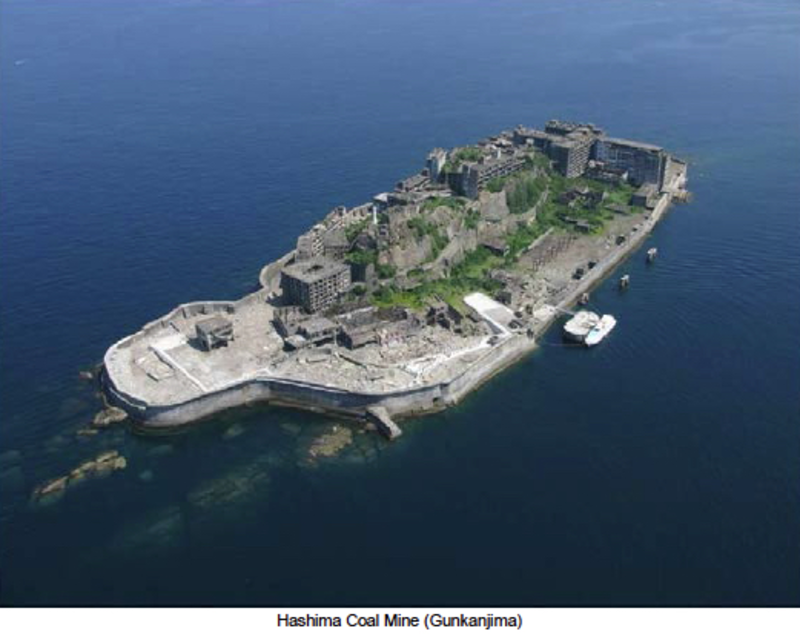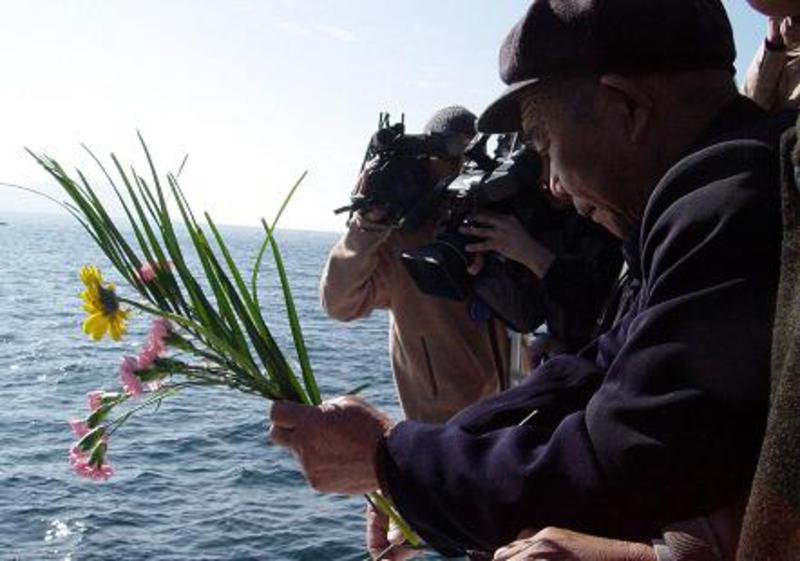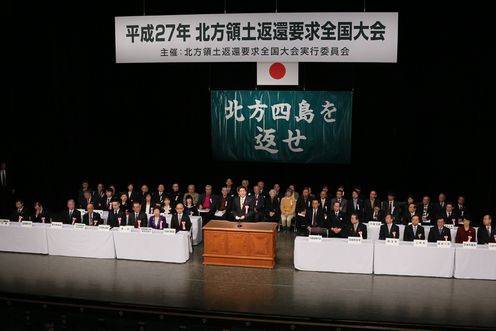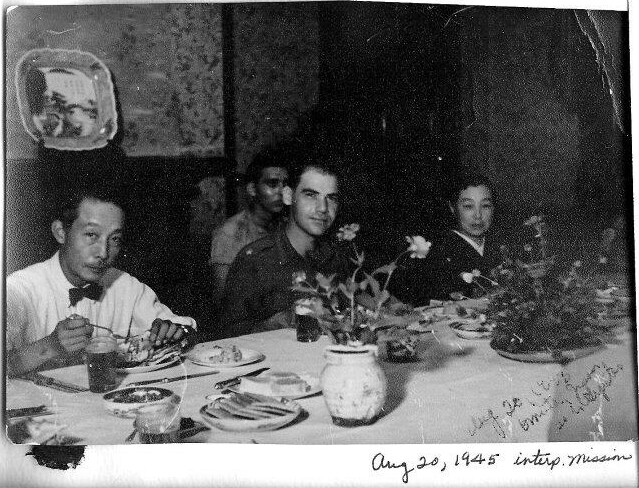Translator’s note: As of 2015 names of National Diet facilities will be slightly different to more closely resemble the translations of facility names on the House of Councillors and House of Representatives websites. (Upper House Plenary Session Hall will now be Upper House Chamber, Lower House 1st Committee Members’ Room will now be Lower House Committee Room No. 1, etc.)Monday, January 26, 2015
AM12:00 At official residence (no visitors)
08:00 At official residence (no morning visitors)
08:55 Depart from official residence
08:56 Arrive at office
09:04 Extraordinary Session Cabinet Meeting begins
09:11 Cabinet Meeting ends
09:14 Meet with Deputy Prime Minister and Minister of Finance Aso Taro
09:57 End meeting with Mr. Aso
10:18 Meet with Ministery of Education, Culture, Sports, Science and Technology (MEXT)’s Minister Shimomura Hakubun and Vice-Minister Yamanaka Shinichi
10:33 End meeting with Mr. Shimomura and Mr. Yamanaka
11:26 Depart from office
11:28 Arrive at Diet
11:29 Enter Lower House Waiting Room No. 14
11:30 General Meeting of LDP Upper and Lower House Members
11:39 Meeting ends
11:40 Speak with LDP Vice-President Komura Masahiko
11:50 Finish speaking with Mr. Komura
11:51 Gathering of LDP Diet Members
11:54 Gathering ends
11:55 Speak with Chairperson of LDP General Council Nikai Toshihiro and Chairperson of LDP Policy Research Council Inada Tomomi
11:56 Finish speaking with Mr. Nikai and Ms. Inada
11:57 Leave Lower House Waiting Room No. 14
11:58 Enter Lower House Chamber
PM12:02 Lower House Plenary Session opens
12:07 Lower House Plenary Session recess
12:08 Leave Lower House Chamber
12:09 Depart from Diet
12:11 Arrive at office
12:37 Depart from office
12:38 Arrive at Diet
12:39 Enter State Minsters’ Room
12:51 Leave room
12:52 Enter Upper House Chamber
01:00 Opening Ceremony for 189th Ordinary Diet Session
01:07 Ceremony ends
01:09 Leave Upper House Chamber
01:12 Depart from Diet
01:13 Arrive at office
01:39 Depart from office
01:40 Arrive at Diet
01:42 Enter Lower House Speaker’s Office. Greet Lower House Speaker Machimura Nobutaka and Vice-Speaker Kawabata Tatsuo. Chief Cabinet Secretary Suga Yoshihide and Deputy Chief Cabinet Secretary Kato Katsunobu also attend
01:49 Leave room
01:51 Enter Upper House President’s Office. Greet President of Upper House Yamazaki Masaaki. Mr. Suga and Mr. Kato also attend
01:53 Leave room
01:54 Enter Upper House Vice-President’s Office. Greet Vice-President of Upper House Koshiishi Azuma
01:55 Leave room
01:57 Enter Lower House Speaker’s Drawing Room
02:00 Leave room, enter Lower House Chamber
02:02 Lower House Plenary Session reconvenes
02:08 Lower House Plenary Session adjourns
02:09 Leave Lower House Chamber
02:10 Enter State Ministers’ Room
02:25 Leave room
02:26 Enter Upper House President’s Reception Room
02:28 Leave room, enter Upper House Chamber
02:29 Speak with Mr. Aso
02:30 Finish speaking with Mr. Aso
02:31 Upper House Plenary Session reconvenes
02:37 Upper House Plenary Session adjourns
02:38 Leave Upper House Chamber
02:39 Depart from Diet
02:41 Arrive at office
02:55 Director of Cabinet Intelligence Kitamura Shigeru and Director of Cabinet Satellite Intelligence Center Shimohira Koji enter
03:10 Mr. Shimohira leaves
03:26 Mr. Kitamura leaves
04:22 Meet with Minister of Foreign Affairs Kishida Fumio, Ministry of Foreign Affairs (MOFA)’s Vice-Minister Saiki Akitaka, Director-General of Middle Eastern and African Affairs Bureau Uemura Tsukasa, and Director-General of Consular Affairs Bureau Miyoshi Mari
04:51 End meeting with Mr. Kishida, Mr. Saiki, Mr. Uemura, and Ms. Miyoshi
04:52 Depart from office
04:54 Arrive at Diet
04:55 Enter LDP Secretary-General’s Conference Room. Endorse candidates for Nara Prefecture and Fukuoka Prefecture gubernatorial elections
05:00 Leave room
05:02 Enter LDP President’s Office
05:03 LDP Officers Meeting
05:19 Meeting ends
05:27 Leave room
05:28 Enter State Ministers’ Room
05:29 Meet with Chairman of LDP Election Strategy Committee Motegi Toshimitsu
05:44 End meeting with Mr. Motegi
05:45 Leave room
05:46 Depart from Diet
05:48 Arrive at office
05:50 Administrative Reform Promotion Council meeting
05:54 Council meeting ends
06:06 Speak with young participant representatives of Cabinet Office’s Global Leaders Development Program
06:18 Finish speaking with representatives of Global Leaders Development Program
07:58 Depart from office
07:59 Arrive at official residence
Tuesday, January 27, 2015AM12:00 At official residence (no visitors)
08:00 At official residence (no morning visitors)
08:16 Depart from official residence
08:18 Arrive at office
08:20 Speak with Deputy Chief Cabinet Secretary Kato Katsunobu
08:25 Finish speaking with Mr. Kato
09:27 Ministerial Council on Promotion of Policies for Dementia Care meeting
09:35 Council meeting ends
09:40 Cabinet Meeting begins
09:53 Cabinet Meeting ends
09:56 Ministerial Council on Tokyo 2020 Olympic and Paralympic Games
10:09 Council meeting ends
10:15 Depart from office
10:21 Arrive at ANA InterContinental Hotel Tokyo in Akasaka, Tokyo
10:23 Speak with Chairman of The Nippon Foundation
Sasakawa Yohei in banquet room Luminous within hotel. Minister of Health, Labour and Welfare Shiozaki Yasuhisa also attends
10:30 Finish speaking with Mr. Sasakawa
10:31 Attend Global Appeal 2015 Announcement Ceremony addressing Leprosy with wife Akie in banquet hall Prominence, deliver address
10:39 Leave ceremony
10:40 Depart from hotel
10:46 Arrive at office
11:22 Meet with Minister of Foreign Affairs Kishida Fumio, MOFA’s Vice-Minister Saiki Akitaka, and Director-General of Middle Eastern and African Affairs Bureau Uemura Tsukasa
11:53 End meeting with Mr. Kishida, Mr. Saiki, and Mr. Uemura
PM12:52 Depart from office
12:53 Arrive at Diet
12:55 Enter Lower House Speaker’s Drawing Room
01:00 Leave room, enter Lower House Chamber
01:02 Lower House Plenary Session opens
03:13 Lower House Plenary Session adjourns
03:14 Leave Lower House Chamber
03:15 Depart from Diet
03:16 Arrive at office
03:29 Meet with Minister of State for Economic and Fiscal Policy Amari Akira, Cabinet Office’s Vice-Minister Matsuyama Kenji and Director-Generals for Policies on Cohesive Society Maekawa Mamoru, Habuka Shigeki, and Tawa Hiroshi
03:52 End meeting with Mr. Amari, Mr. Matsuyama, Mr. Maekawa, Mr. Habuka, and Mr. Tawa
03:56 Receive courtesy call from Mayor of Hofu City (Yamaguchi Prefecture) Matsuura Masato of Education Rebuilding Leaders Council and other council members
04:08 Courtesy call ends
04:33 Council on National Strategic Special Zones meeting
04:53 Council meeting ends
05:10 Exchange of opinions with patients concerning dementia policies. Mr. Shiozaki also attends
05:35 Finish exchanging opinions
06:04 Receive courtesy call from First Deputy Prime Minister of Uzbekistan Rustam Sadikovich Azimov
06:26 Courtesy call ends
07:32 Depart from office
07:33 Arrive at official residence
Wednesday, January 28, 2015
AM12:25 Meet with Chief Cabinet Secretary Suga Yoshihide
12:42 End meeting with Mr. Suga
01:50 At official residence (no visitors)
08:00 At official residence (no morning visitors)
08:25 Depart from official residence
08:26 Arrive at office
08:27 Meet with Deputy Chief Cabinet Secretary Seko Hiroshige
09:24 End meeting with Mr. Seko
09:25 Speak with Minister of Foreign Affairs Kishida Fumio, MOFA’s Vice-Minister Saiki Akitaka, and Director-General of Middle Eastern and African Affairs Bureau Uemura Tsukasa. Mr. Suga also attends
09:35 Finish speaking with Mr. Kishida, Mr. Saiki, and Mr. Uemura
09:37 Ministerial Council meeting
09:43 Council meeting ends
09:44 Interview open to all media: When asked “What did you talk discuss in the Ministerial Council meeting?” Mr. Abe answers “In these grave circumstances, the government is coming together as one to take direction and strive deliberately toward Mr. Goto Kenji’s swift release.”
09:45 Interview ends
09:51 Depart from office
09:53 Arrive at Diet
09:54 Enter Upper House President’s Reception Room
09:58 Leave room, enter Upper House Chamber
10:01 Upper House Plenary Session opens
11:24 Upper House Plenary Session recess
11:25 Leave Upper House Chamber
11:26 Depart from Diet
11:28 Arrive at office
PM12:53 Depart from office
12:54 Arrive at Diet
12:56 Enter Upper House President’s Reception Room
12:58 Leave room, enter Upper House Chamber
01:01 Upper House Plenary Session reopens
02:11 Speak with Mr. Suga
03:37 Speak with Mr. Kishida
03:38 Finish speaking with Mr. Kishida
03:55 Upper House Plenary Session adjourns
03:56 Leave Upper House Chamber
04:00 Enter Lower House Committee Room No. 1
04:02 Lower House Budget Committee convenes
04:06 Budget Committee adjourns
04:07 Leave room
04:09 Enter Upper House Committee Room No. 1
04:13 Upper House Budget Committee convenes
04:18 Budget Committee adjourns
04:19 Leave room
04:22 Depart from Diet
04:23 Arrive at office
05:27 Education Rebuilding Implementation Council meeting
05:47 Council meeting ends
07:34 Depart from office
07:36 Arrive at official residence
Thursday, January 29, 2015
AM01:40 At official residence (no visitors)
07:27 Depart from official residence
07:28 Arrive at office
07:29 Meet with Deputy Chief Cabinet Secretary Kato Katsunobu
08:29 End meeting with Mr. Kato
08:42 Depart from office
08:43 Arrive at Diet
08:44 Enter State Ministers’ Room
08:45 Speak with Minister of Foreign Affairs Kishida Fumio and Chief Cabinet Secretary Suga Yoshihide
08:51 Finish speaking with Mr. Kishida and Mr. Suga
08:52 Leave room
08:53 Enter Lower House Committee Room No. 1
08:59 Lower House Budget Committee opens
PM12:00 Lower House Budget Committee recess
12:01 Leave room
12:03 Depart from Diet
12:05 Arrive at office
12:32 Ministerial Council meeting
12:35 Council meeting ends
12:53 Depart from office
12:54 Arrive at Diet
12:56 Enter Lower House Committee Room No. 1
01:00 Lower House Budget Committee reopens
05:03 Lower House Budget Committee adjourns
05:04 Leave room
05:06 Depart from Diet
05:08 Arrive at office
05:13 Speak with Special Advisor to the Prime Minister Kimura Taro
05:16 Finish speaking with Mr. Kimura
05:17 Meet with Director of National Security Council (NSC) Yachi Shotaro, Director of Cabinet Intelligence Kitamura Shigeru, MOFA’s Director-General of Foreign Policy Bureau Hiramatsu Kenji, Ministry of Defense (MOD)’s Director-General of Bureau of Defense Policy Kuroe Tetsuro and Chief of Staff for Joint Staff Council Kawano Katsutoshi
05:41 End meeting with Mr. Yachi, Mr. Kitamura, Mr. Hiramatsu, Mr. Kuroe, and Mr. Kawano
06:06 Industrial Competitiveness Council meeting
06:45 Council meeting ends
07:52 Depart from office
07:53 Arrive at official residence
Friday, January 30, 2015
AM01:40 At official residence (no visitors)
06:40 At official residence (no morning visitors)
07:00 Depart from official residence
07:02 Arrive at office
07:03 Meet with Deputy Chief Cabinet Secretary Kato Katsunobu
08:02 End meeting with Mr. Kato
08:03 Headquarters for Promoting Decentralization Reform meeting
08:08 Meeting ends
08:14 Meet with Minister of Foreign Affairs Kishida Fumio. Chief Cabinet Secretary Suga Yoshihida also attends
08:43 End meeting with Mr. Kishida
08:50 Depart from office
08:51 Arrive at Diet
08:53 Enter Lower House Committee Room No. 1
08:55 Speak with Mr. Suga
08:56 Finish speaking with Mr. Suga
08:59 Lower House Budget Committee opens
PM12:02 Lower House Budget Committee recess
12:03 Leave Lower House Committee Room No. 1
12:05 Depart from Diet
12:07 Arrive at office
12:08 Meet with Mr. Kato
12:27 End meeting with Mr. Kato
12:54 Depart from office
12:55 Arrive at Diet
12:57 Enter Lower House Committee Room No. 1
12:58 Speak with Deputy Prime Minister and Minister of Finance Aso Taro
12:59 Finish speaking with Mr. Aso
01:00 Lower House Budget Committee reopens
04:18 Lower House Budget Committee adjourns
04:19 Leave Lower House Committee Room No. 1
04:20 Speak with Minister of Defense Nakatani Gen
04:21 Finish speaking with Mr. Nakatani
04:22 Depart from Diet
04:24 Arrive at office
04:25 Speak with LDP Secretary-General Tanigaki Sadakazu
04:28 Finish speaking with Mr. Tanigaki
04:54 Council on Economic and Fiscal Policy meeting
05:31 Council meeting ends
05:32 Meet with Vice-Minister for Foreign Affairs Saiki Akitaka
06:02 End meeting with Mr. Saiki
06:21 Depart from office
06:23 Arrive at Diet
06:24 Enter Lower House Speaker’s Drawing Room
06:30 Leave room, enter Lower House Chamber
06:32 Lower House Plenary Session opens
07:12 Speak with Minister in charge of Overcoming Population Decline and Vitalizing Local Economy in Japan Ishiba Shigeru
07:13 Finish speaking with Mr. Ishiba
07:14 Lower House Plenary Session adjourns
07:15 Leave Lower House Chamber
07:16 Make rounds to Lower House Speaker Machimura Nobutaka, Vice-Speaker Kawabata Tatsuo, Chairman of Lower House Committee on Rules and Administration Hayashi Moto, New Komeito, and LDP. Mr. Aso, Mr. Kato, and Chairman of LDP Diet Affairs Committee Sato Tsutomu also attend
07:24 Depart from Diet
07:25 Arrive at official residence
Saturday, January 31, 2015
AM12:00 At official residence (no visitors)
08:00 At official residence (no morning visitors)
Stay at official residence throughout morning (no vistors)
PM05:00 Meet with Minister of Foreign Affairs Kishida Fumio, Chief Cabinet Secretary Suga Yoshihide, Deputy Chief Cabinet Secretary for Crisis Management Nishimura Yasuhiko, Director of NSC Yachi Shotaro, Director of Cabinet Intelligence Kitamura Shigeru, and MOFA’s Vice-Minister Saiki Akitaka and Director-General of Middle Eastern and African Affairs Bureau Uemura Tsukasa
05:40 End meeting with Mr. Kishida, Mr. Suga, Mr. Nishimura, Mr. Yachi, Mr. Kitamura, Mr. Saiki, and Mr. Uemura
Sunday, February 1, 2015
AM12:00 At official residence (no visitors)
06:15 Depart from official residence
06:16 Arrive at office
06:42 Interview open to all media: Concerning the video of the killing of Goto Kenji being open to the public, Mr. Abe says “These circumstances came to a truly sorrowful extreme. I will never forgive these terrorists. Japan will steadfastly fulfill its responsibility in the international community combatting terrorism.”
06:44 Interview ends
07:04 Ministerial Council meeting
07:11 Council meeting ends
07:31 NSC meeting commences. Chairperson of National Public Safety Commission Yamatani Eriko also attends
07:44 NSC meeting closes
07:45 Meet with Minister of Foreign Affairs Kishida Fumio and MOFA’s Director-General of Foreign Policy Bureau Hiramatsu Kenji. Chief Cabinet Secretary Suga Yoshihide also attends
08:22 End meeting with Mr. Kishida and Mr. Hiramatsu
08:23 Depart from office
08:24 Arrive at official residence
PM01:30 Meet with Deputy Chief Cabinet Secretary Seko Hiroshige
03:34 End meeting with Mr. Seko
06:43 Phone conference with Queen of Jordan Rania Al Abdullah. Deputy Chief Cabinet Secretaries Kato Katsunobu and Mr. Seko, MOFA’s Administrative Vice-Minister Sugiyama Shinsuke and Director-General of Middle Eastern and African Affairs Bureau Uemura Tsukasa also attend
06:58 Phone conference ends
Provisional Translation by: Erin M. Jones






















 UNESCO is expected to approve 23 similar Japanese-nominated sites. Absent will be any accounting of the dark histories associated with these mines, foundries, and shipyards. Silence about the full history of these would-be global landmarks undermines UNESCO’s international goals and the U.S.-Japan alliance.
UNESCO is expected to approve 23 similar Japanese-nominated sites. Absent will be any accounting of the dark histories associated with these mines, foundries, and shipyards. Silence about the full history of these would-be global landmarks undermines UNESCO’s international goals and the U.S.-Japan alliance.
 World Heritage sites often become tourist attractions and many nations view the designation as a path to reviving fading regions and cities. That is one motive behind Japan’s nomination of its sites. But the selective telling of their history is part of the Abe administration’s broader policy of restoring Japanese pride in their past.
World Heritage sites often become tourist attractions and many nations view the designation as a path to reviving fading regions and cities. That is one motive behind Japan’s nomination of its sites. But the selective telling of their history is part of the Abe administration’s broader policy of restoring Japanese pride in their past.






